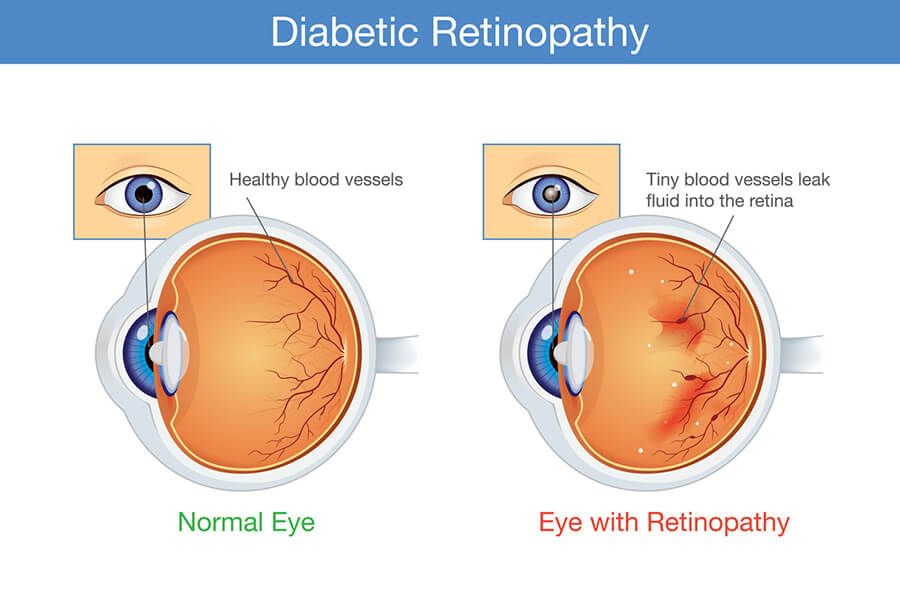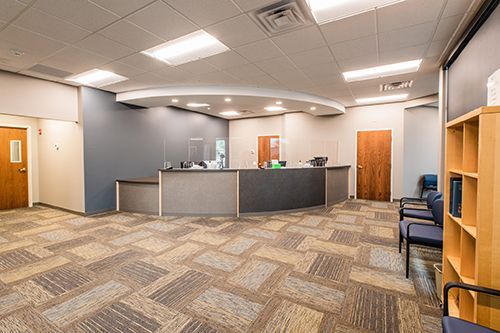Diabetes & Vision Health – Understanding Diabetic Eye Care and Risks
Diabetes is a complex and invasive disease that can cause myriad health problems in nearly all of the body’s major systems. This includes a number of conditions that can impact the eyes and a person’s ability to see. One of the most devastating is diabetic retinopathy, which can ultimately lead to loss of vision and even blindness.
November is Diabetes-Related Eye Disease Month, so let’s take a closer look at how this disease can impact vision and eye health and the importance of diabetic eye care.
Diabetic Retinopathy
As the name implies, diabetic retinopathy can occur in the retinas of an individual with diabetes. Due to the impact of diabetes, the blood vessels in the body that feed the eye and retina can be weakened, causing them to bulge or even leak – a condition known as nonproliferative diabetic retinopathy. If uncontrolled, the disease can progress further, developing into proliferative retinopathy. In these patients, the blood vessels that have been damaged close off entirely, causing the formation of new vessels on the surface of the retina, leading to further and more serious vision problems.

In early stages, the disease is often imperceptible, though symptoms may include reduced visual acuity at distance or close up. More advanced cases may lead to visual artifacts such as eye floaters or streaks in the vision that may or may not clear up. If left untreated, the disease can progress further, leading to secondary conditions such as diabetic macular edema – a swelling of the macula causing blurred vision that occurs in about half of cases – or neovascular glaucoma, which can block the routine drainage of fluid from the eye. In severe cases, it can even cause the retina to detach from the back the eye.
Other Diabetic Vision Issues
In addition to diabetic retinopathy, having diabetes can increase your risk for two other severe eye conditions glaucoma and cataracts. We’ve discussed each of these conditions previously in the blog, as they can occur in any person, but studies show that diabetics have nearly double the risk of developing these conditions of a non-diabetic person. This makes it all the more critical for those with diabetes to schedule an annual diabetic eye care appointment to look for any early symptoms of these or other diseases and discuss steps you can take to maintain your eye and visual health.
Another potential complication of diabetes is blurred vision as a result of excessive blood sugar levels. If your blood sugar level gets too high, it can cause your eyes’ lenses to swell, which can impact how light travels through the eye and cause things to look blurry. Fortunately, this symptom is easily controlled by better managing blood sugar levels and often can be reversed within a few days or weeks. However, diabetic patients with blurry vision should be sure to see their eye doctor as soon as symptoms occur as blurry vision can also be symptomatic of the other, more severe diabetes-related conditions discussed.
Prevention And Early Detection
The best way to prevent diabetic retinopathy is controlling your blood sugar. It is important to know your Hemoglobin A1 level (HbA1c), which gives you information about your blood sugar control over the past several months. Commonly used guidelines from the American Association of Clinical Endocrinologists and the American Diabetes Association suggest an HbA1c goal range of 7 percent to 8 percent for most patients to prevent diabetic complications. The Diabetes Control and Complications Trial (DCCT) showed a strong exponential relationship between the risk of diabetic retinopathy and the mean HbA1c level, with each 10 percent decrease in the HbA1c (e.g., from 9 percent to 8.1 percent), showing a 39 percent decrease in the risk of progression of retinopathy.
The National Institute of Diabetes and Digestive and Kidney Diseases also suggests that individuals with diabetes have annual eye exams. For Type 1 diabetics, annual exams should begin within five years of being diagnosed; Type 2 diabetics should start annual exams immediately after diagnosis. The NIDDKD also suggests that women who are diabetic and pregnant should have an exam within the first trimester, and follow their doctor’s recommendations for follow-up exams through their child’s first birthday. Expectant mothers who were not previously diabetic, but who develop gestational diabetes are not typically believed to be at any increased risk, but should raise any concerns with their eye doctor during pregnancy.
The American Academy of Ophthalmology adds that for most diabetics, diabetic retinopathy in some form may be nearly unavoidable. The Wisconsin Epidemiologic Study of Diabetic Retinopathy (WESDR) followed both Type 1 and Type 2 diabetic patients over the course of 20 years, finding that 99 percent of patients with Type 1 diabetes and 60 percent of Type 2 diabetics had signs of at least some degree or retinopathy. Maintaining annual visits with your eye doctor can help monitor your overall eye health, however, and provide an opportunity for your physician to notice any problems early before the disease can progress.
Schedule Your Diabetic Eye Exam At Ross Eye Institute
Diabetes is a complex whole-body disease, but with routine care and maintenance, it doesn’t have to cause issues with your vision. At Ross Eye Institute, our ophthalmologists, optometrists and other care professionals can handle every aspect of your diabetic eye care. Schedule an appointment with us today at any of our three convenient Western New York locations by calling 716.881.7900 for patients in Buffalo and our Amherst location serving the Northtowns, or 716.677.6500 for Southtowns residents to visit our Orchard Park office.





Contact Us
We will get back to you as soon as possible.
Please try again later.
BUFFALO NIAGARA
F: 716-881-4349
Office Hours:
Monday - Friday: 8:00 am - 4:30 pm
SOUTHTOWNS OFFICE
F: 716-677-6507
Office Hours:
Monday - Friday: 8:00 am - 4:30 pm
BUFFALO NIAGARA
F: 716-881-4349
Office Hours:
Monday - Friday: 8:00 am - 4:30 pm
SOUTHTOWNS OFFICE
F: 716-677-6507
Office Hours:
Monday - Friday: 8:00 am - 4:30 pm


© 2024. Ross Eye Institute.
The Ross Eye Institute website makes every attempt to comply with The Americans with Disabilities Act (ADA) of 1990. If you are using a screen reader and are having problems using this website, please call for assistance.
